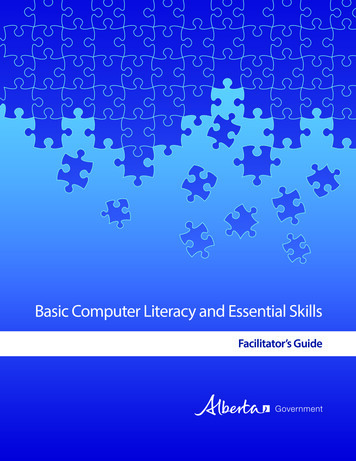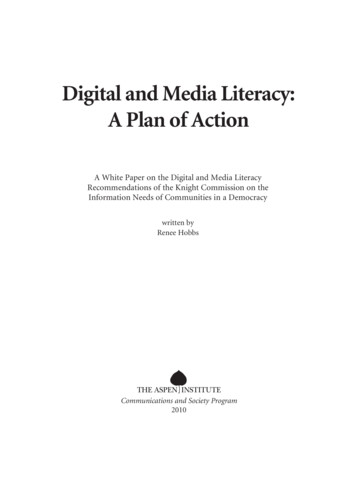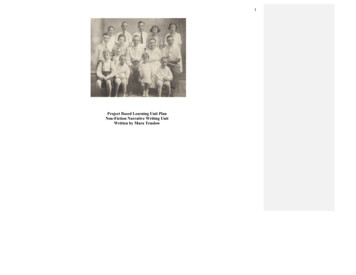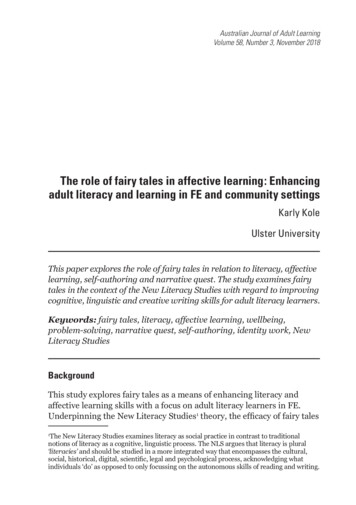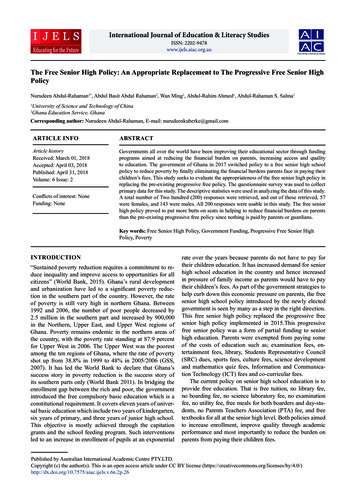
Transcription
International Journal of Education & Literacy StudiesISSN: 2202-9478www.ijels.aiac.org.auThe Free Senior High Policy: An Appropriate Replacement to The Progressive Free Senior HighPolicyNurudeen Abdul-Rahaman1*, Abdul Basit Abdul Rahaman2, Wan Ming1, Abdul-Rahim Ahmed1, Abdul-Rahaman S. Salma1University of Science and Technology of ChinaGhana Education Service, Ghana12Corresponding author: Nurudeen Abdul-Rahaman, E-mail: nurudeenkuberke@gmail.comARTICLE INFOABSTRACTArticle historyReceived: March 01, 2018Accepted: April 03, 2018Published: April 31, 2018Volume: 6 Issue: 2Governments all over the world have been improving their educational sector through fundingprograms aimed at reducing the financial burden on parents, increasing access and qualityto education. The government of Ghana in 2017 switched policy to a free senior high schoolpolicy to reduce poverty by finally eliminating the financial burdens parents face in paying theirchildren’s fees. This study seeks to evaluate the appropriateness of the free senior high policy inreplacing the pre-existing progressive free policy. The questionnaire survey was used to collectprimary data for this study. The descriptive statistics were used in analyzing the data of this study.A total number of Two hundred (200) responses were retrieved, and out of those retrieved, 57were females, and 143 were males. All 200 responses were usable in this study. The free seniorhigh policy proved to put more butts on seats in helping to reduce financial burdens on parentsthan the pre-existing progressive free policy since nothing is paid by parents or guardians.Conflicts of interest: NoneFunding: NoneKey words: Free Senior High Policy, Government Funding, Progressive Free Senior HighPolicy, PovertyINTRODUCTION“Sustained poverty reduction requires a commitment to reduce inequality and improve access to opportunities for allcitizens” (World Bank, 2015). Ghana’s rural developmentand urbanization have led to a significant poverty reduction in the southern part of the country. However, the rateof poverty is still very high in northern Ghana. Between1992 and 2006, the number of poor people decreased by2.5 million in the southern part and increased by 900,000in the Northern, Upper East, and Upper West regions ofGhana. Poverty remains endemic in the northern areas ofthe country, with the poverty rate standing at 87.9 percentfor Upper West in 2006. The Upper West was the poorestamong the ten regions of Ghana, where the rate of povertyshot up from 38.8% in 1999 to 48% in 2005/2006 (GSS,2007). It has led the World Bank to declare that Ghana’ssuccess story in poverty reduction is the success story ofits southern parts only (World Bank 2011). In bridging theenrollment gap between the rich and poor, the governmentintroduced the free compulsory basic education which is aconstitutional requirement. It covers eleven years of universal basic education which include two years of kindergarten,six years of primary, and three years of junior high school.This objective is mostly achieved through the capitationgrants and the school feeding program. Such interventionsled to an increase in enrollment of pupils at an exponentialrate over the years because parents do not have to pay fortheir children education. It has increased demand for seniorhigh school education in the country and hence increasedin pressure of family income as parents would have to paytheir children’s fees. As part of the government strategies tohelp curb down this economic pressure on parents, the freesenior high school policy introduced by the newly electedgovernment is seen by many as a step in the right direction.This free senior high policy replaced the progressive freesenior high policy implemented in 2015.This progressivefree senior policy was a form of partial funding to seniorhigh education. Parents were exempted from paying someof the costs of education such as; examination fees, entertainment fees, library, Students Representative Council(SRC) dues, sports fees, culture fees, science developmentand mathematics quiz fees, Information and Communication Technology (ICT) fees and co-curricular fees.The current policy on senior high school education is toprovide free education. That is free tuition, no library fee,no boarding fee, no science laboratory fee, no examinationfee, no utility fee, free meals for both boarders and day-students, no Parents Teachers Association (PTA) fee, and freetextbooks for all at the senior high level. Both policies aimedto increase enrollment, improve quality through academicperformance and most importantly to reduce the burden onparents from paying their children fees.Published by Australian International Academic Centre PTY.LTD.Copyright (c) the author(s). This is an open access article under CC BY license ://dx.doi.org/10.7575/aiac.ijels.v.6n.2p.26
The Free Senior High Policy: An Appropriate Replacement to The Progressive Free Senior High Policy There are several studies conducted on the impact offunding on enrollment and students’ academic performance.For instance, the Free education introduced in South Africain some areas enabled poor parents to enroll their children inschool (Boatman & Long, 2016; Blanco & Meneses, 2010;Dynarski & Scott-Clayton, 2013; Garlick, 2013; Melguizo,2011 and Taryn & Claudia M. 2012). Other studies alsofound funding to be useful in improving the academic performance of students. These studies are Denny et al. (2014)Moussa et al. 2015 Natasha et al. (2011) Stater (2009) Tatiana et al. (2016).Looking at what has been done in the past, this studytakes a step further to evaluate the new education policyagainst the pre-existing progressive free senior high education policy in regards to poverty alleviation among parentsand quality of education in the Wa Municipality of Ghana.This study would evaluate the two policies based onwhat parents or guardians say and not what politicians saybecause parents are the direct beneficiaries of the economicimpact of the two policies.Objective-Evaluate the effectiveness of the free senior high policywhich replaced the progressive free senior high policyin reducing poverty in the Wa Municipality of Ghana.Research Question-Is the free senior high policy an appropriate replacementto the progressive free senior high policy in reducingpoverty in the Wa Municipality of Ghana?The Senior High School System in GhanaThe educational system in Ghana follows a 6-3-3-4 system.Senior high school education covers three years for students aged 15 to 17 years. There are 863 (562 public andprivate 301) senior high schools which cater for the needs of837,204 students. There are 34,304 teachers in public seniorhigh schools of which 86.7% are trained. The sub-programhas an in-service training program for teachers to ensure thatthey have up-to-date knowledge of the curriculum and related teaching and learning materials (MOE, 2016).Subjects taught in the senior high schools are English,Integrated Science, Mathematics and Social studies as coresubjects and students are required to select a group of elective subjects from seven elective groupings of subjects.It is this level of education that is currently being offeredfor free and had been previously progressively free beforeSeptember 2017.LITERATURE REVIEWThe literature of the study is reviewed according to themes.These themes are, the empirical evidence of the study detailing the significance of funding in reducing the burden onparents paying fees. There is some evidence from previousstudies relating the effect of funding to schools on parents or27guardians. Most of these studies showed a positive relationship between funding and poverty alleviation. For instance,Joseph, Laura, Peter and Jonathan (2000) after carryingout research, suggested that the American government andother institutions can relieve burdens on families by promoting saving and reducing the cost of college attendancethrough expanded financial aid.Similarly, in 2015, more than 300 students from differentprivate colleges were asked to talk about the impact of theUS State Grant program, and this is what one of the studentssaid “My family is low-income and I am the first-generationstudent. It is difficult for my family to understand the supportI need to obtain a four-year degree. Without the State Grant,I would not be going to St Olaf. I would probably be workingan ordinary job and not pursuing a college career” (ZoulaLor, 2015).According to Todora and Smith (2006), “Widespread abject poverty creates conditions in which the poor have noaccess to credit, are unable to finance their children’s education, and, in the absence of physical or monetary investmentopportunities, have many children as a source of old-age financial security”. In the same vein Obeng (2012) declares: Cost of education has been identified to constitute asignificant proportion of the income of most people inGhana whose daily lives are visited by abject poverty.Taking giant steps to bring economic recovery to its citizens through education, the Government of Ghana hastaken the burden off parents through the implementationof the capitation grant policy. (p. 2)The introduction of free primary education led to the poorenrolling their children in schools in Uganda (Deininger,2003). Also, in a later study, Olwande et al. (2010) assessedthe effect of Free Primary Education in rural Kenya applyingpanel data from about 1500 households between 2000 and2007, to check the enrollment trends. They found out thatparents could enroll their students in school because of theimplementation of Free Primary Education.Another study indicated that children from high-incomefamilies perform better than children from needy families inareas such as communication skills, knowledge of numbers,ability to concentrate and in playing with other children in acooperative manner (Thomas, 2007).A study carried out by Janus et al. (2007) found thatschools with the highest number of children with low schoolreadiness were from areas of high social risk and poverty. Inline with this, Willms (2007) stated thatchildren from lower socioeconomic status (SES) households scored lower on a receptive vocabulary test thanhigher SES children. Thus, the evidence is clear andunanimous that poor children arrive at school at a cognitive and behavioral disadvantage. Schools are obviously not in a position to equalize this gap. For instance,research by The Institute of Research and Public Policy(Montreal, Quebec) showed that differences betweenstudents from low and high socioeconomic neighborhoods were evident by grade 3; children from low socioeconomic neighborhoods were less likely to pass agrade 3 standards test.
28 Finally, Akyeampong (2009) argued that funding for senior high school education is necessary to make it easier forpeople from needy families to participate in education and inreducing the financial burden on parents.Source of Funding to Senior High SchoolsGarcia-Penalosa and Wald (2000) are of the view that, acquiring literacy and numeracy is a fundamental human requirement and Pettinger (2012) who argued that educating individual benefits the society more than the individual as it equips aperson with social values that enhance national unity.The heightened demand for secondary education is accompanied by the need to respond to the twin challenges ofincreasing access to and also, improving quality and significance of secondary education. It, therefore, calls for more efficient sources of funding secondary education (World Bank,2013). These arguments, therefore, makes it justifiable forthe financing of senior high education.In all countries worldwide, a significant portion of nationalresources, both public and private, are channeled to education.The rationale for sustaining this fact is compelling. A qualityeducation, beginning with primary education, is fundamentalin endowing individuals with the capacity to successfully pursue their private goals. It also equips them with the knowledge and skills, as well as the values and attitudes, necessaryto contribute effectively to the economic, social and politicaldevelopment of their societies (Saavedra, 2002).Education in Ghana is mainly financed from public resources, even though the private sector is also playing animportant role. Public sources of funding comprise The Ghana Education Trust Fund, the District Assemblies CommonFund (DACF), the Ministry of Education, youth and sports(MOEYS), the Student Loan Scheme, and the ScholarshipSecretariat (African Development Fund, 2003).The internally generated funds and loans, grants and donations the government of Ghana gets were used in subsidizing the cost of senior high education to improve equal accessfor all. The Government of Ghana launched the progressively free senior high School Education in September 2015, andan amount of GH 12,178,544.00 ( 2,744334) was releasedto the ministry of Education for the first term of 2015/2016academic year to fund the progressive free policy (MOE,2015). The free senior high school education policy pursuedcurrently is supposed to cover the full cost of education. Anamount 100 million (GH 400 million) by the governmentwas to absorb the cost of senior high education and make itentirely free for the 2017/2018 academic year (MOE, 2017).The government of Ghana and the World Bank Groupsigned a 156 million financing agreement to improve equalaccess to secondary education in under-served districtsthroughout the country. The fund was to help enroll 30,000new senior high students, improve learning outcomes for150,000 students in low-performing schools and communities, and 2000 senior high school teachers, head teachers,and other education officials (World Bank, 2014).Since the establishment of the Skills Development Fund(SDF) in 2010, the Danish government has been consistentlysupporting Ghana with 15 million every year to give moreIJELS 6(2):26-33people access to technical and vocational training MOE(2017).GoG government of Ghana, IGF internal generatedfund, GET fund Ghana education trust fund, highlyindebted poor country, MDRI multi-lateral debt reliefinitiative. Table 1 shows the sources of funding to SeniorHigh Education in Ghana.METHODThe objective of this paper is to evaluate the free senior highschool education policy currently being pursued in Ghanaas an appropriate replacement for the previous progressivelyfree policy in the Wa Municipality of Ghana. The Wa Municipality is located in the upper west region of Ghana. Thereare six (6) senior high schools and out of these six schools,five schools are public senior high schools.SampleOut of six (6) senior high schools in the Wa Municipality,five schools were targeted in this study because they are public schools and beneficiaries to government funding. Fifty(50) students were sampled in each school in all levels andwere asked to give questionnaires to their parents. The students were taken from all classes at senior high schools because students in classes 2 and 3 benefited from progressivefree high school policy while those in class 1 benefited fromthe free senior high policy.InstrumentThe study applied the qualitative method to examine theviews of parents, and the questionnaire survey was used incollecting data for this study. Two hundred and fifty (250)questionnaires were given to students from five (5) publicsenior high schools to be filled by their parents. Studentswhose parents were illiterates were asked to read questionsto their parents and guide them to respond. Parents or guardians’ signatures or thumbprints were required on each questionnaire with dates and telephone numbers to ensure thecredibility of each response. The Likert scale with five levelswas used: strongly agree, agree, uncertain, strongly disagree,disagree, coded as 5 to 1, respectively.Data AnalysisA total number of 200 responses were retrieved, and out ofthose retrieved, 57 were females, and 143 were males. All the200 responses were usable and analyzed using the descriptivestatistics. The targeted respondents were parents because theyare those who pay fees and benefit from the progressive free andfree senior high policies. The Statistical Package for Social Science (SPSS) software was used as software in the data analysis.RESULTSA total number of two hundred (200) questionnaires wereretrieved, 57 of the valid questionnaires were females rep-
29The Free Senior High Policy: An Appropriate Replacement to The Progressive Free Senior High Policy resenting 28.5%, and 143 were males representing 71.5%which is indicated in Table 3. The reason for more males isbecause of the assumption that, men are the breadwinners ofthe family. Table 2 describes the age of two-hundred (200)parents or guardians who were contacted during the survey.It revealed that the mean age is forty-nine (49) years witha standard error of 0.89829. The minimum and maximumages of parent or guardian are twenty-three (23) and eightysix (86) respectively. Table 3 reveals that only 1% and 3.5%of parents or guardians respectively disagree and stronglydisagree that education brings about individual and societalgrowth with 2.5% uncertain of the prospects of education.However, with 34% of parents or guardians agreeing thateducation is the key to development, more than 50% of thepopulation is of the firm conviction that education propelsindividual and societal growth and development. The table indicates that majority of parents or guardians stronglyagreed that education is the key to progress and thus have realized education is necessarily an important vehicle to bringpositive change to individuals and society in general.It is not surprising to see that more than 60% of parentsor guardians strongly agreed that education determines thefuture direction of an individual as revealed in Table 3. Morethan 50% strongly agreed that education propels individualand societal growth and development. The table indicatedthat majority of parents or guardian are well enlightenedthat education is the surest way to growth and development.However, financial issues often bared so many pupils fromenrolling into senior high school. With government intervention, a lot of parents or guardians (30%) agreed that thefinancial assistance from government had cushioned them tocomfortably send their wards to school without any financialstress. In contrast to the view of almost same number, 28.5%strongly disagreed to the accession that the government subsidies helped them to enroll their children into senior highschool. More than 50% of parents or guardians are in oneway, or another know the Progressive Free Senior Highschool (PFSHS) as revealed in the table. While 36% areaware of PFSHS, 41% are firmly aware. These statisticsindicate that majority of the populace are aware of PFSHSwhile 18.5% are either uncertain of the policy or entirelyunaware of it. Under PFSHS policy, 51% of contacted persons are paid less money for their wards SHS education thanthe period without PFSHS, 1% are uncertain of the impactof the program, and 47% disagreed to have paid less. Thosewho strongly oppose to have paid less under the policy arein a slight majority than those who agreed to have paid less.However, those with uncertainty are in a minority. Table 3further showed that more than 70% of parents or guardianshave agreed that PFSHS has improved the quality of education. Indeed, less than 30% of parents or guardians do notaccept that the policy has improved the quality as well as theaccess to education.Table 3 revealed that the current policy thus Free SeniorHigh School (FSHS) has been given low publicity becauseabout 52% of parents or guardians are unaware of FSHSwhile only 41.5% of parents or guardians know of the policy.Interestingly, about 11% of the parents contacted are uncertain of the existence of FSHS. From the table, it is quiteclear that majority are not aware of FSHS though its implementation.The Free Senior High School policy (FSHS) as indicatedby the government covers only the first year students thatupon its implementation. However, the table showed theFSHS covers not all students (73%), and 23% agreed to itthus. The 23% of the people responses are not out of placeas the majority of the respondents were not aware of FSHSand hence would not comprehend the pith of free senior highpolicy.As to whether the Free Senior High School (FSHS)would improve quality of education and its access, 60% ofrespondents indicated that the policy would positively affectthe quality of education. While 7% are uncertain of the policy’s improving quality of education, 6.5% of them say thepolicy has no bearing on the quality of education. However,a majority of 26.5% of respondents strongly disagree thatTable 1. Source of government funding to senior high schools (MOE, 9,113,62810,667,891HIPC/MDRIAnnual budget funding amount (ABFA)GoG government of Ghana, IGF internal generated fund, GET fund Ghana education trust fund, highly indebted poor country,MDRI multi‑lateral debt relief initiative.Table 2. Descriptive statistics results for participants’ agesNMinimumMaximumMeanStandard ard d N (listwise)200N number, std standard.
30 IJELS 6(2):26-33Table 3. Descriptive statistics results for parents’ responsesQuestionsFrequencyPercentCumulative ercentStrongly t Applicable10.595.5Strongly disagree73.599.0Disagree21.0100Strongly agree13266.066.0Agree5829.095.0Not applicable10.595.5Strongly disagree52.598.0Disagree42.0100Strongly agree4623.023.0Agree6030.053.0Uncertain84.057.0Not applicable10.557.5Strongly disagree5728.586.0Disagree2814.0100Strongly ot applicable73.591.0Strongly disagree94.595.5Disagree94.5100Strongly agree6231.031.0Agree4221.052.0Uncertain21.053.0Not applicable84.057.0Strongly disagree4623.080.0Disagree4020.0100Strongly t applicable63.089.5Strongly disagree73.593.0Disagree147.0100Strongly . Education propels individual and societal growth and development2. Senior high school education determines an individual future direction3. Without government funding my child could not enroll into senior highschool4. Aware of progressive free SHS policy5. Under the progressive SHS policy, I paid less for my child6. The progressive senior high policy has improved the quality and access tosenior high education7. I am aware of the free senior high school policy(Contd.)
31The Free Senior High Policy: An Appropriate Replacement to The Progressive Free Senior High Policy Table 3. (Continued)QuestionsFrequencyPercentCumulative ercentNot Applicable63.055.5Strongly disagree5427.082.5Disagree3517.5100Strongly disagree14673.073.0Disagree5427.0100Strongly t applicable136.573.5Strongly disagree3919.593.0Disagree147.0100Strongly agree2914.514.5Agree157.522.0Uncertain157.529.5Not applicable84.033.5Strongly disagree6130.564.01008. The free senior high policy covers all students in senior high schools9. The free senior high policy will improve quality of education10. I have paid some amount to enroll my child to senior high school underfree senior policyDisagree7236.0TOTAL200100.0the policy would improve the quality of education. Therefore, there is no denying the fact that the policy will entirelyenhance the quality of education.One of the basics of Free Senior High School (FSHS) isthat no parents or guardians are expected to pay any dime fortheir ward to enter the senior high school which would helpreduce poverty in the Municipality. However, based on ourresults (Table 3) more than 50% of parents or guardians paidno amount of money for their ward to enroll into SHS. It issurprising some insisted they had to pay some funds becausesome head teachers charged fees at the blind side of the government. The government must, therefore, ensure that headteachers do not charge these illegal fees to achieve its aim ofreducing poverty drastically in the Wa Municipality and thenation as a whole.DISCUSSIONThe results showed that the free senior high policy is an appropriate replacement to the pre-existing progressive freepolicy but more needs to be done to improve the program toachieve its aim of reducing poverty among parents, improving quality and access to senior high education in the WaMunicipality of Ghana.As indicated in the results, 34% of parents or guardiansagreed that education is the key to development and morethan 50% of the population is of the strong conviction thateducation propels societal growth and development. Theimportance of education is further emphasized by morethan 60% of parents who strongly agreed that senior higheducation determines an individual’s direction. It, therefore, ascertains the fact that investing in senior high education through any of the policies under the study has beena remarkable achievement of the government of Ghana toimprove both access and quality to education and more significantly reducing poverty in the country. This correspondsto the view, a quality education, beginning with primary education, is fundamental to endow individuals with the capacity to successfully pursue their private goals. While at thesame time equipping them with the knowledge and skills,as well as the values and attitudes, necessary to contributeto the economic, social and political development of theirsocieties (Garcia-Penalosa & Wald, 2000; Pettinger, 2012;Saavedra, 2002).Government funding in the form of the pre-existing progressive free policy and the free senior high policy currentlybeing enjoyed is proven to have reduced the financial difficulties parents go through in paying the children fees. Itis evident in the results of this study, and thus 30% agreedthat the funding from the government had cushioned themto comfortably send their wards to school without any financial stress. It would, in the long run, see to the reduction of poverty among families and the overall developmentof the nation since parents would pay less or nothing fortheir children’s education. More than 28% of parents orguardians strongly disagreed to the accession that government subsidies helped them to enroll their children to senior high school and this is because they are not aware the
32 government absorbed some of the cost of their children’seducation under the progressive free policy. Their ignorance of the policy is shown in the results which showedthat 41% are firmly unaware of the progressive free policy.Children can be equipped with knowledge and skills to takeup proactive roles in the society if they are given qualityeducation at the senior high level. About 70% of parents orguardians have agreed that the progressive free policy hasimproved the quality of education as against less than 30%of parents or guardians who do not accept that the policyhas improved the quality as well as the access to education.With the free senior high policy, 60% of respondents indicated that the policy would positively affect the quality ofeducation against 26.5% of respondents that strongly disagree the policy would improve the quality of education.This because the free senior high policy has been given lowpublicity as 52% of parents or guardians are unaware of itin the Wa Municipality. The free senior high policy coveredall costs related to senior high school but is still seen to be abit deficient in reducing poverty because it does not includeall the students in school, and some of the head teachers arecharging illegal fees which are supposed to be covered bythe policy. This is shown in the results as, 73% agreed itdoes not cover all students, and more than 10% of parentsadmitted they have paid for their children’s education underthe free senior high policy.The free senior high policy has helped needy familiesto enroll their children in school and hence reducing financial pressures on parents since they do not pay anything. Itgoes in line with the results of earlier studies carried out by(Acheampong, 2009; Deininger, 2003; Janus et al., 2007; Joseph, Laura, Peter & Jonathan, 2000; Olwande et al. 2010;Raymond O., 2012; Tadono & Smith, 2006; Thomas, 2007;Willms, 2007).We can justifiably state that the progressive free seniorhigh policy was a good policy but the free senior highpolicy would be better in solving the high rate of the poverty problem in the Wa Municipality. Parents paid nothingfor their children who enrolled to senior high during the2017/2018-year group aside from the illegal fees chargedby some head teachers and the fees some still paid fortheir children in senior high level 2 and level 3. This freesenior high policy if well managed would lead to a drastic reduction of poverty in the Wa Municipality and thewhole nation at large. The study has some recommendations based on the challenges identified by the free seniorhigh policy, and these recommendations are detailed laterin this paper.CONCLUSIONThe free senior high policy proved to put more butts on seatsin helping to reduce financial burdens on parents than thepre-existing progressive free policy since nothing is supposed to be paid by parents or guardians and this would leadto a drastic reduction of poverty in the Wa Municipality. Forthe Free senior high policy to completely cut down poverty,the government must ensure that it would always be ‘just asit says on the tin.’ Free should not be pseudo-free.IJELS 6(2):26-33RECOMMENDATIONSThere are some recommendations based on the outcome ofthe study.First and
The Free Senior High Policy: An Appropriate Replacement to The Progressive Free Senior High Policy Nurudeen Abdul-Rahaman 1*, Abdul Basit Abdul Rahaman 2, Wan Ming 1, Abdul-Rahim Ahmed 1, Abdul-Rahaman S. Salma 1University of Science and Technology of China 2Ghana Education Service, Ghan





